The HP TouchPad Review: webOS on the Big Screen
by Anand Lal Shimpi on July 17, 2011 11:11 PM ESTThe webOS Browser
Based on WebKit, the TouchPad's browser is pretty comparable to what you get from Apple or Google on competitive tablets. Technically the browser doesn't support tabs but you can spawn new browser windows as cards on a stack.
Functionally this ends up working pretty similar to tabs and you do get a sliver of a preview of the card you're switching to, so there's a slight advantage. On the flip side, while you can just tap once to switch between tabs on Honeycomb you need to swipe up then tap to do the same under webOS 3. In practice I'd say it's a wash.
There is no support for an incognito mode like you get in Honeycomb, however you can clear all browser history/cookies/cache from within the app itself using its drop down menu:
Scrolling down web pages is consistent on the TouchPad but rendering happens below 30 fps. This is an issue across the OS unfortunately, the Web app is not an exception.
Scroll beyond the top or bottom of a web page and you'll meet a grey background, similar to what happens on iOS. The same applies for left/right scrolling, again similar to iOS. The problem here is the webOS browser is more sensitive to scrolling beyond left/right boundaries so unless you're very careful to scroll in a straight line you can actually have a more jittery scroll down a web page. This seems like an easy fix if HP just makes scrolling beyond the left/right edges of a web page require a more substantial gesture.
Double tap and pinch to zoom are both supported and work well. Occasionally when zooming you'll find that certain web page elements are poorly reconstructed:
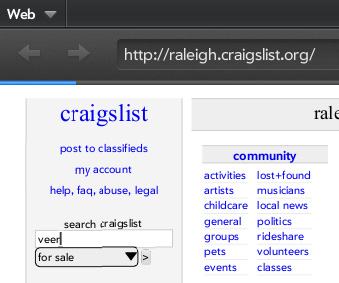
Default search is powered by Google although you can sub in Wikipedia or Twitter if you'd like.
The TouchPad's browser reports a fairly standard user agent:
Mozilla/5.0 (hp-tablet; Linux; hpwOS/3.0.0; U; en-US) AppleWebKit/534.6 (KHTML, like Gecko) wOSBrowser/233.70 Safari/534.6 TouchPad/1.0
Web page compatibility is comparable to the iPad and Honeycomb tablets but not much better. I ran The HTML5 Test on an iPad 2, Honeycomb (3.1) tablet, RIM's PlayBook and the TouchPad to quantify compatibility:
| The HTML5 Test | |||||||
| Test | Apple iPad 2 | HP TouchPad | RIM PlayBook | Samsung Galaxy Tab 10.1 | |||
| Total Score | 217 (and 7 bonus points) | 229 (and 5 bonus points) | 274 (and 9 bonus points) | 222 (and 3 bonus points) | |||
| Parsing rules | 1/11 | 6/11 | 11 (2 bonus points) | 11 (2 bonus points) | |||
| Canvas | 20 | 20 | 20 | 20 | |||
| Video | 21/31 (4 bonus points) | 21/31 (4 bonus points) | 21/31 (4 bonus points) | 21/31 | |||
| Audio | 20 (3 bonus points) | 20 (1 bonus point) | 20 (3 bonus points) | 20 (1 bonus point) | |||
| Elements | 14/28 | 16/28 | 20/28 | 20/28 | |||
| Forms | 36/98 | 41/98 | 47/98 | 52/98 | |||
| User Interaction | 7/36 | 34/36 | 34/36 |
7/36 | |||
| History and navigation | 5 | 0/5 | 5 | 0/5 | |||
| Microdata | 0/15 | 0/15 | 0/15 | 0/15 | |||
| Web applications | 19/20 | 15/20 | 15/20 | 15/20 | |||
| Security | 5/10 | 5/10 | 5/10 | 5/10 | |||
| Geolocation | 15 | 15 | 15 | 15 | |||
| WebGL | 8/25 | 0/25 | 0/25 | 0/25 | |||
| Communication | 25 | 15/25 | 25 | 5/25 | |||
| Files | 0/20 | 0/20 | 0/20 | 10/20 | |||
| Storage | 15/20 | 15/20 | 15/20 | 15/20 | |||
| Workers | 0/15 | 0/15 | 15 | 0/15 | |||
| Loca multimedia | 0/20 | 0/20 | 0/20 | 0/20 | |||
| Notifications | 0/10 | 0/10 | 0/10 | 0/10 | |||
| Other | 6 | 6 | 6 | 6 | |||
Overall scores are pretty similar for the iPad and the TouchPad. Honeycomb is a bit better (save for the annoying bug with Reddit) and the PlayBook's browser is in a class of its own. While not quite desktop-level, the PlayBook's browser continues to be the most compatible browser in the tablet world by far. How the competition is unable to come close is perplexing to me.
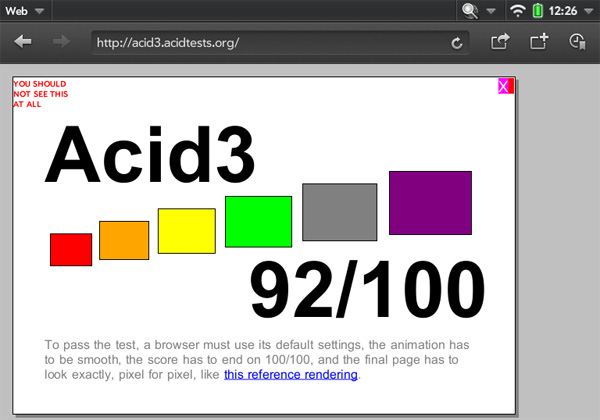
The TouchPad doesn't completely pass the Acid3 test unfortunately, putting it behind iOS and Android in that regard.
On the plus side there is full blown Flash support. I turned to GUIMark 3 to quantify the TouchPad's Flash performance:
| Flash/HTML5 Performance - GUIMark 3 | ||||||||
| Bitmap (HTML5 Cache) | Bitmap (Flash) | Vector Test (HTML5) | Vector Test (Flash) | Compute (HTML5) | Compute (Flash) | |||
| Apple iPad 2 (1024 x 768) | 19.1 fps | N/A | 14.2 fps | N/A | 13.4 fps | N/A | ||
| BlackBerry PlayBook (1024 x 600) | 11.2 fps | 26.3 fps | 10.7 fps | 25.9 fps | 10.2 fps | 23.0 fps | ||
| HP TouchPad (1024 x 768) | 27.7 fps | 42.6 fps | 9.3 fps | 28.5 fps | 8.0 fps | 22.1 fps | ||
| HTC Flyer (1024 x 600) | 30.3 fps | 50.6 fps | 12.1 fps | 21.4 fps | 8.5 fps | 26.6 fps | ||
| Samsung Galaxy Tab 10.1 (1280 x 800) | 22.9 fps | 25.0 fps | 11.4 fps | 19.3 fps | 11.2 fps | 23.6 fps | ||
While not as good as the Flyer, the TouchPad's Flash performance is clearly better than that of the Galaxy Tab 10.1 running Android 3.1. HTML5 performance on the other hand is noticeably lower. Web page loading performance isn't anywhere near as good as the competiton:
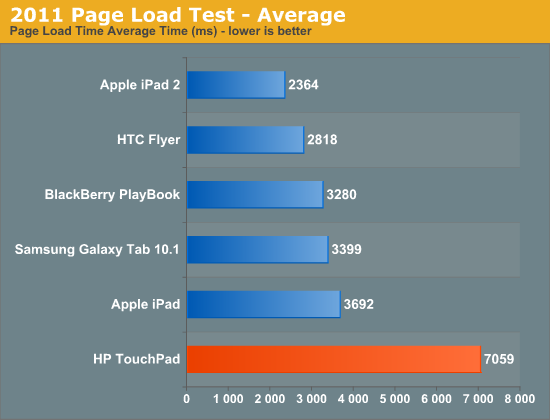
The same performance deficit is reflected in SunSpider and BrowserMark tests:
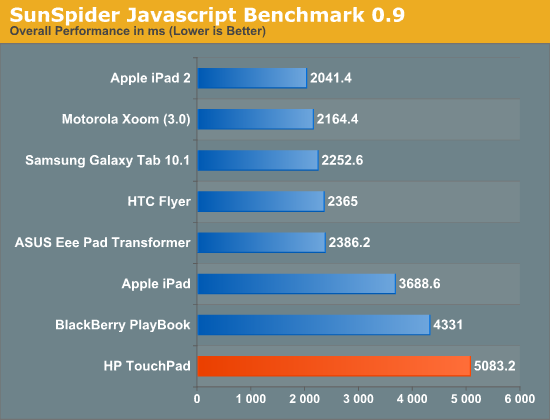
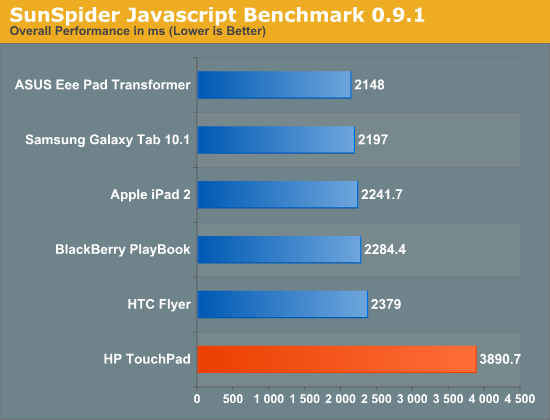
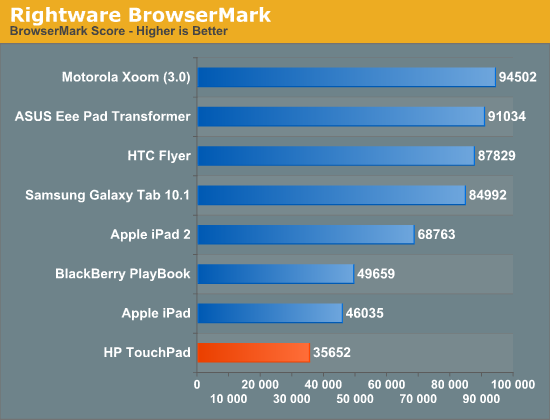
In practice, browsing web pages with Flash ads is a relatively painless experience on the TouchPad - similar to Honeycomb in that regard. It's in playing video where the user experience can degrade. This isn't a problem unique to the TouchPad, while it's nice to have full Flash support - tablets with Flash just aren't quite fast enough to duplicate the desktop, or even a netbook experience. While I do expect that to change in the next two years, we're just not there yet. I was surprised by how well playback controls in Flash video players worked on the TouchPad. They weren't flawless, but I could actually get around a lot of videos using them.
On a side note, Hulu currently works on the TouchPad although I expect by the time you read this that hole will be plugged.


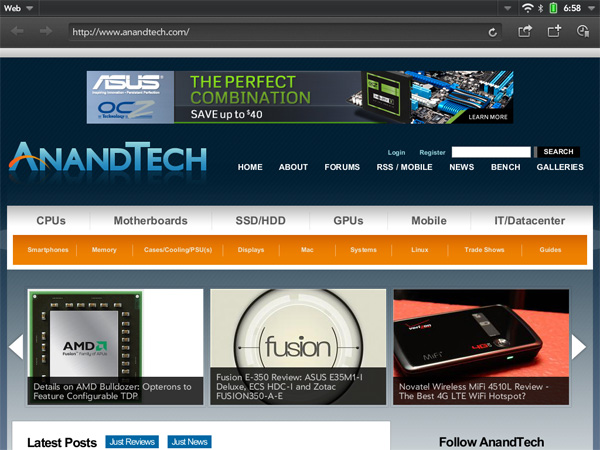

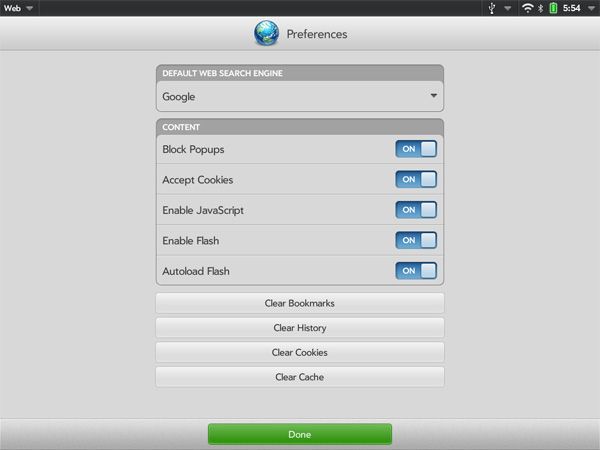









67 Comments
View All Comments
Conner_36 - Monday, July 18, 2011 - link
because its a free marketkmmatney - Monday, July 18, 2011 - link
I agree - at this price there isn't much incentive. At this time, it seems like the iPad 2 is still the better device. I don't think WebOS gives you any more "freedom" than iOS.bpgd - Monday, July 18, 2011 - link
This is the review I have been waiting for. As always Anand's review is gold standard. He goes into details and really tells how the thing works.NeoReaper - Monday, July 18, 2011 - link
I feel bad writing this comment because this is actually the first time I've ever posted anything on Anandtech and I've been coming to this site since its inception. I have a lot of respect for virtually every article I have ever read on this site written by Anand with the exception of this one. This is only an opinion but I feel like this review isn't nearly as critical as it should be. Based on what I've read in regards to performance, battery life, bugs, etc.. this device doesn't deserve the pass that you gave (at least that's the impression I get from reading this) This device has too many underlying flaws that haven't been addressed, mainly being the OS performance issues that have existed since the original Pre. Why criticize Skype performance when the screenshot you have cleaerly shows a large number of system services sapping CPU usage for no good reason? I mean, really? Pulseaudio is using almost 27% CPU usage. Maybe I'm interpreting this review incorrectly... I just feel that you were hoping for this device to deliver but reality it doesn't and you're simply hoping that OS updates will resolve the performance issues. If you want to believe that, why not expect the competition to make an update to the OS which boasts features that will make it better for office productivity? Hope is for fanboyism, a reviewer should be deliver facts without twisting it with what could be. Your final words are completely contradictory to itself. I hope you re-examine your review. As I've said already, I have great respect for you, Anand, and I've praised virtually every article you have ever written, but this article I cannot.lunarx3dfx - Tuesday, July 19, 2011 - link
One thing you might want to keep in mind though, is that while pulseaudio was using 27% of CPU resources, is that necessarily HP's fault? I would be more inclined to believe that the fault lies with the developers of pulseaudio for not making a well optimized app.Now, I'm not excusing the glaring flaws with the Touchpad, however I have not noticed the majority of the performance issues reviewers have seen with my personal TP. That's why in an earlier comment I wanted to know what build of the OS Anand's unit is running. I think reviewers got an earlier build that may not be as optimized as the release build.
I was in Staples the other day, and the demo unit was running build 16 whereas the release models are running build 41.
NeoReaper - Tuesday, July 19, 2011 - link
i see your comment regarding the build number now, it would be very interesting to hear back from Anand regarding the build he was running and whether or not any performance issues have really been fixed. as for the pulseaudio thing, pulseaudio is a linux audio service so the state of its optimization would be HP's fault. It is not a third party application. As I said, my main gripe with the review is that even in the final words portion of his article, many statements are contradictory. How productive can it be when he states that the unit is runs slower than its main competitors in virtually every aspect? How can you justify weight and size with such poor battery life and performance? Maybe I'm being a bit too harsh but the problem is, all the underlying "performance" issues that he states are in the Touchpad are the same problems that plagued the Pre, Pixi, and Pre2. I would love for HP to "fix" the performance issue, but maybe its not really that easy to "fix".lunarx3dfx - Tuesday, July 19, 2011 - link
I forgot about pulse being a linux service. Whoops. lol. I can expplain the extra weight and thickness of the device though. Well, HP did. The reason it is so much thicker and heavier according to them, which makes sense to me, is the inclusion of the inductive charging coils.NeoReaper - Tuesday, July 19, 2011 - link
ahh, ok ok, that makes sense.Leonick - Monday, July 18, 2011 - link
The keyboard is actually pretty impressive compared to the competitors, having both a numbers row with special characters and a tab key.I also like how it handles the settings compared to iOS, having settings in the individual apps make a lot more sense in my mind that a centralized app, still iOS apps can do this if the developers choose to and when there are any settings you might want to change more than once or while running the app the generally do so.
Seems they got notifications pretty right for a tablet too. Pretty similar to how honeycomb does it it looks like. I think the system coming with iOS 5 will do fine for the iPad but it's still not perfect, it seem to be lacking statusbar icons to show that you have notifications and it would be neat if it could display upcoming calendar events and not just events with reminders (like the cydia app Lockinfo does).
Also, it was mentioned how the system was similar to notifications on a PC, well that's understandable, they do have plans to put WebOS on PCs.
Belard - Tuesday, July 19, 2011 - link
I agree with you on the keyboard. When I played with the Playbook, I noticed the keyboard right away and LOVE it... iOS and Android should COPY this onto their own devices... ah, let the lawsuits fly.When you have passwords that are combos of numbers and letters, going back and forth can through you off (it does me).
I'd give HP/WebOS a 10 for the keyboard. I'd give Android and iOS a 6 in comparison.
The Settings Icons for WebOS are a pain.... You have to open one after the other, and if you DON'T close the, they'll stay in memory - constantly running.